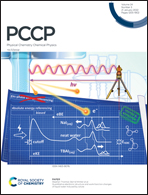Pseudorotaxane formation affected by stereo-electronic effects. A theoretical and experimental study†
Abstract
We report a theoretical and experimental study on different complexes of pseudorotaxanes possessing pyridine axles. In order to evaluate the stereo-electronic effects of the methyl substituents in the pyridine ring, complexes with different substitution patterns were synthesized. In this way, it was possible to analyze the different behaviors of these complexes according to the positions of their methyl substituents. Combined techniques of molecular dynamics and quantum mechanical calculations with the help of molecular electrostatic potentials for a simpler visualization of the electronic effects were employed. We have sought experimental support of NMR spectroscopy analysis to corroborate the conclusions obtained from the molecular simulations. Our results not only clearly demonstrate that both electronic and steric effects play key roles in the feasibility of the formation of such complexes, but also the simulations reported here might predict the degree of difficulty of their formation. The combination of computational techniques employed here seems to be an excellent approach to be able to predict whether or not a complex can be formed and with what degree of difficulty. In addition, our experimental and theoretical results have allowed us to visualize the formation of external complexes in the rotaxanes reported here. In this case, the use of bolaforms with trimethylammonium groups at both ends was very useful to evaluate in detail the formation of the so-called external complexes in these systems.



 Please wait while we load your content...
Please wait while we load your content...